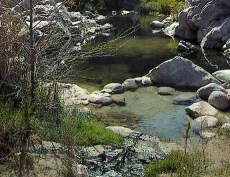Change writes rerun in forest
Mark Muckenfuss
07/12/2003
The San Bernardino National Forest is changing.
Right before the eyes of its residents, thousands of pine trees are dying. Those already dead are being cut down and removed at a rate of as many as 5,000 per week.
Experts estimate that even at that pace, it will take three to four years to clear the forest of the already dead trees. And new ones are going from green to brown every day, victims of a prolonged drought and an infestation of bark beetles.
When the trees are gone, the environment atop the mountains will have a decidedly different feel. Instead of thick stands of deep green pine foliage, the hillsides will be dominated by oaks that have struggled for survival amid the shade of the tall trees. Cypress and other firs will remain, but their volume is far below that of the Jeffrey and ponderosa pines that are turning into standing tinder.
Someone revisiting the mountains five or 10 years from now might not even recognize the place.
But it's not the first time the local forests have undergone a change. Manmade and natural disasters have been visited upon the region throughout its recorded history, beginning with the Mormon pioneers.
When Brigham Young's followers arrived here in 1852, big trees, the kind for building houses, were a bit few and far between in the valley. But there were plenty of tall straight pines lining the rim of the mountains.
So the Mormons took to the hills. Amasa Lyman and a few other men established a sawmill on Mill Creek, near what is now Forest Home, in 1853. But the real lumber work would take place in the main stretch of the San Bernardino range and it wasn't long before a road was being built to gain access -- and egress -- from the Crestline area.
Get this. In his book "The San Bernardinos," author John Robinson writes that once the Mormon council decided to build the road, nearly every able-bodied man in San Bernardino pitched in. In a matter of two weeks, the road was cleared and graded from the bottom of Waterman Canyon to the top of the mountain.
Later that year, the first steam-powered sawmill in the mountains went into operation between modern-day Crestline and Lake Gregory. Local demands were satisfied rather easily, but Los Angeles was growing and local timber was a hot commodity. Eventually, 14 mills were in operation -- at one time or another -- between Crestline and Running Springs.
The mountains changed.
Whole areas of forest were clear cut, leaving nothing but stumps and manzanita scrub. The largest lumber operation, Brookings Lumber Co. in Running Springs, ceased operations in 1912 largely because it had cut three-quarters of the trees on its holdings, Robinson writes. Those holdings stretched from what is now Heap's Peak to Green Valley Lake. The only trees left standing were those in areas too difficult to get to.
In the 1950s, significant chunks of the forest changed again. This time because of an infestation of -- stop me if this sounds too familiar -- bark beetles. The Big Bear Timber Co. in Redlands was contracted to remove diseased and dead trees on 5,000 acres near Barton Flats. In a single year, says Robinson, 7 million board feet of lumber was removed.
Nothing like a little deja vu.
Reach Mark Muckenfuss at (909) 368-9595 or mmuckenfuss@pe.com
dejavu bark beetle disaster
All posts are those of the individual authors and the owner
of this site does not endorse them. Content should be considered opinion
and not fact until verified independently.
| Subject | Author | Views | Posted |
|---|---|---|---|
| katrina island | 1466 | July 16, 2003 02:53PM |
Sorry, only registered users may post in this forum.



